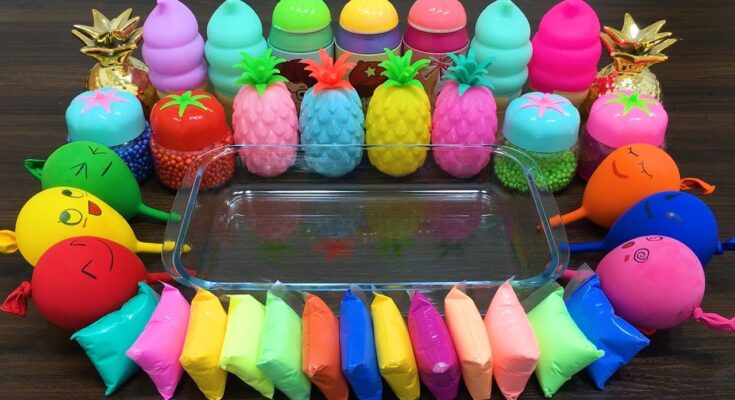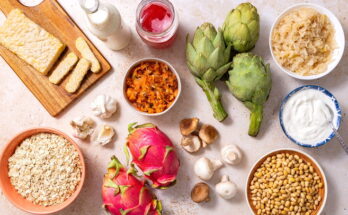Slime Recipe: Slime has become one of the most popular crafts for kids, teenagers, and even adults. This versatile, colorful, and fun material can be customized in endless ways.
By making slime at home, you can choose the colors, textures, and effects you like, creating a unique sensory experience with every batch.
Plus, it’s an excellent hands-on activity that can keep everyone entertained and let you explore basic science concepts.
Safety Precautions for Making Slime
When it comes to making slime, safety should always be a priority. Using safe ingredients and avoiding certain chemicals will ensure that your slime-making experience is both fun and secure.
- Choose Non-Toxic Ingredients: Always opt for safe, non-toxic ingredients when making slime at home. Avoid using harsh chemicals, especially if kids are involved in the process.
- Avoid Borax for Younger Kids: Some recipes call for borax, which can cause skin irritation in some individuals. There are alternative, borax-free recipes that work well and are safer for little hands.
- Supervision is Key: Younger children should always be supervised when making or playing with slime. Ensuring they don’t put any of the slime or ingredients in their mouths will keep them safe from accidental ingestion.
Essential Ingredients for Homemade Slime
The core ingredients you’ll need for slime are simple and inexpensive. While most slime recipes include glue, water, and an activator, you can customize these basics in many ways.
Basic Ingredients:
- Glue: White school glue is the most commonly used, but clear glue can create a see-through effect.
- Activator: Common slime activators include borax solution, baking soda with contact lens solution, and liquid starch.
- Water: To adjust the consistency and make the slime stretchier.
Optional Add-Ins:
- Colors: Food coloring, liquid watercolors, or acrylic paints.
- Textures: Glitter, beads, foam balls, or sequins.
- Scent: Essential oils or extracts can make your slime smell delightful.
Tools and Equipment Needed
Gathering the right tools before starting will make the slime-making process smooth and hassle-free.
- Mixing Bowls: Have separate bowls for different batches.
- Measuring Spoons and Cups: Accurate measurements will help achieve the right consistency.
- Mixing Utensils: Use wooden sticks or plastic spoons that can be discarded or easily cleaned.
- Storage Containers: Airtight containers or ziplock bags will help preserve the slime for future use.
Step 1: Prepare the Workspace
Setting up a clean, organized workspace is crucial for a mess-free slime experience.
- Cover the Table: Use a disposable tablecloth or newspaper to protect the surface from spills and stains.
- Gather Ingredients and Tools: Arrange all ingredients and tools within reach to make the process efficient.
- Keep Clean-Up Supplies Handy: Paper towels or wipes will help you manage any accidental spills along the way.
Step 2: Basic Slime Recipe with Glue and Borax
This classic slime recipe is easy to follow and offers a stretchy, satisfying texture.
Ingredients:
- 1 cup white school glue
- 1 cup warm water
- 1 teaspoon borax powder
- 1 additional cup of warm water for dissolving borax
Instructions:
- Mix the Glue and Water: In a bowl, combine the glue and 1 cup of warm water. Stir until fully mixed.
- Prepare the Borax Solution: In a separate bowl, dissolve the borax in 1 cup of warm water. Stir until it is completely dissolved.
- Combine Both Mixtures: Slowly add the borax solution to the glue mixture, stirring continuously. As you stir, the slime will start to form.
- Knead the Slime: Once the mixture thickens, use your hands to knead the slime until it reaches a stretchy, smooth consistency. Add a few drops of food coloring if desired for a fun, vibrant color.
Tip: If the slime feels too sticky, add a bit more borax solution. If it becomes too stiff, try kneading it with wet hands to soften it up.
Alternative Recipe: Borax-Free Slime
For those looking to avoid borax, this borax-free slime recipe is a fantastic alternative that’s just as fun to make.
Ingredients:
- 1 cup white school glue
- 1 cup baking soda
- 2-3 tablespoons contact lens solution
Instructions:
- Combine Glue and Baking Soda: In a mixing bowl, stir together the glue and baking soda until well blended.
- Add Contact Solution: Gradually add the contact lens solution, one tablespoon at a time, until the slime starts to pull away from the sides of the bowl and form a cohesive ball.
- Knead the Slime: Remove the slime from the bowl and knead it until smooth. You can add colors or textures to customize the slime.
Tip: The contact lens solution should contain boric acid and sodium borate, which help activate the slime.
Fluffy Slime Recipe with Shaving Cream
Fluffy slime has a light, airy texture that kids love. Shaving cream is the key to achieving this fun, puffy effect.
Ingredients:
- 1 cup white school glue
- 3-4 cups shaving cream
- 1 tablespoon baking soda
- 2-3 tablespoons contact lens solution
Instructions:
- Mix Glue and Shaving Cream: In a large mixing bowl, combine the glue with the shaving cream. Stir until smooth and fluffy.
- Add Baking Soda: Add the baking soda and stir well. This will help the slime maintain its fluffy texture.
- Activate with Contact Solution: Slowly add the contact lens solution until the mixture starts to pull away from the bowl and forms a fluffy, stretchy slime.
- Knead: Knead the slime until it is smooth and airy. Add a few drops of color if you want to customize it further.
Tip: For an extra boost of fluffiness, add an extra cup of shaving cream!
Clear Slime Recipe
If you’re looking to create a transparent, crystal-clear slime, this recipe is perfect for you. Clear slime looks great with glitter, confetti, or other colorful additions.
Ingredients:
- 1 cup clear glue
- 1 cup warm water
- 1 teaspoon borax powder
Instructions:
- Combine Glue and Water: In a bowl, mix the clear glue with warm water until fully blended.
- Dissolve Borax in Water: In a separate container, dissolve the borax powder in 1 cup of warm water.
- Combine Both Solutions: Gradually add the borax solution to the glue mixture, stirring continuously until it begins to thicken.
- Knead and Let it Settle: Knead the slime until smooth, and let it sit for a few hours in an airtight container to clear up any bubbles for a glassy appearance.
Tip: The longer you let clear slime sit, the clearer it becomes. Avoid over-stretching it, as this can create air bubbles.
Butter Slime Recipe with Clay
Butter slime is a fan favorite for its soft, buttery texture. This recipe uses modeling clay to give the slime a smooth, spreadable feel that’s incredibly satisfying to play with.
Ingredients:
- 1 cup white school glue
- 1 tablespoon baking soda
- 2-3 tablespoons contact lens solution
- 1/2 cup soft modeling clay (such as Daiso clay)
Instructions:
- Mix Glue and Baking Soda: In a bowl, combine the glue with baking soda, stirring until well incorporated.
- Add Contact Solution: Gradually add the contact lens solution until the slime starts pulling away from the bowl and becomes stretchy.
- Add the Clay: Knead the soft modeling clay into the slime until fully blended. This step might take a few minutes, but soon you’ll notice a smooth, buttery consistency.
- Customize: Add food coloring if desired to make your butter slime pop.
Tip: If the slime feels too stiff, add a few drops of water and knead it in until you reach the desired softness.
Glow-in-the-Dark Slime Recipe
Glow-in-the-dark slime is a fun twist that’s perfect for evening play! You can achieve this effect by using glow powder or glow-in-the-dark paint.
Ingredients:
- 1 cup clear glue
- 1 tablespoon baking soda
- 2-3 tablespoons contact lens solution
- 1-2 tablespoons glow-in-the-dark powder or a few drops of glow-in-the-dark paint
Instructions:
- Combine Glue and Baking Soda: In a mixing bowl, combine clear glue with baking soda, stirring thoroughly.
- Add Glow Powder or Paint: Mix in the glow-in-the-dark powder or paint. Make sure it’s fully combined for an even glow.
- Activate with Contact Solution: Gradually add the contact lens solution, stirring until the slime begins to pull away from the sides of the bowl.
- Charge the Glow: To make your slime glow, expose it to a bright light for a few minutes. Once charged, turn off the lights and watch it glow!
Tip: You can add different colors of glow powder for a multicolored, glowing effect.
Adding Colors and Glitter to Slime
Customizing slime with colors and glitter can add a whole new level of fun and creativity. Here’s how to do it without making a mess or staining your hands.
- Choosing the Right Colors: Food coloring, liquid watercolors, or acrylic paint can all be used to color slime. Start with a few drops and add more if needed.
- Adding Glitter: Glitter can be mixed in at any stage of the slime-making process. Fine glitter gives a subtle shimmer, while chunky glitter adds a bold sparkle.
- Swirling Colors: For a fun effect, add a few drops of different colors to the slime and knead gently to create a marbled look without fully mixing.
Tip: Wear disposable gloves when adding colors to avoid staining your hands, especially when using liquid dyes or paints.
Tips for Adjusting Slime Consistency
Sometimes slime doesn’t turn out quite right, but there are ways to fix it! Here are some troubleshooting tips to get your slime back to the perfect consistency.
- Too Sticky: If your slime is too sticky, add a small amount of activator (such as a few more drops of borax solution or contact lens solution) and knead until the stickiness reduces.
- Too Runny: To thicken runny slime, add a bit more baking soda or glue. Knead and test the consistency after each addition.
- Too Hard or Rubbery: If your slime feels too hard, try adding a few drops of water and kneading it in. You can also try adding a small amount of lotion or baby oil for extra softness.
Tip: Always add additional ingredients a little at a time. Small adjustments can make a big difference in the final texture.
Storing and Preserving Slime
To keep your slime fresh and stretchy, proper storage is essential. Storing it well can help it last for weeks or even months.
- Use Airtight Containers: Place your slime in an airtight container or a ziplock bag to prevent it from drying out. Make sure to seal the container tightly.
- Keep in a Cool Place: Store your slime at room temperature, away from direct sunlight, as heat can cause it to dry out or change consistency.
- Hydrate as Needed: If your slime starts to dry out over time, add a few drops of water or lotion and knead to restore its texture.
Tip: For clear slime, store it in a container for a few days to allow any bubbles to rise to the top. This will help it become more transparent.
Fun Ideas for Using and Playing with Slime
There are endless ways to enjoy slime beyond just squishing it! Here are some fun and creative ideas to take your slime play to the next level.
- Sensory Play: Stretching, poking, and squishing slime can be a fantastic sensory experience for children. It helps develop fine motor skills and promotes relaxation.
- Hide Small Objects: For a treasure-hunt effect, hide small plastic animals or beads in the slime and let kids dig them out.
- Educational Experiments: Use slime as a hands-on science experiment. You can mix different colors, textures, or even observe how slime reacts to temperature changes.
Tip: Always supervise younger children during play, especially when adding small items that could be a choking hazard.
Cleaning Up After Making Slime
While slime is fun to make and play with, it can get messy! Knowing how to clean up properly can make the whole process smoother.
- Cleaning Surfaces: Wipe down surfaces with warm, soapy water to remove any slime residue. If slime is stuck, use a vinegar solution to loosen it.
- Removing Slime from Clothes: To remove slime from clothing, allow it to dry, then gently scrape off as much as possible. Use a mixture of vinegar and warm water to soak any remaining slime, and wash as usual.
- Slime in Hair: If slime ends up in hair, don’t panic! Use a generous amount of conditioner and warm water to gently work it out without tugging.
Tip: Keep a small bowl of warm water and soap nearby to clean hands easily during the slime-making process.
FAQs about Slime Recipe
1. What ingredients do I need for a basic slime recipe?
For a simple slime recipe, you’ll need glue, baking soda, and contact lens solution. Optional add-ins include food coloring, glitter, or small beads for added texture and color.
2. How do I make slime without borax?
To make slime without borax, you can use glue and contact lens solution, which acts as an alternative activator. Simply mix glue with a bit of baking soda and slowly add contact solution until the slime reaches your desired consistency.
3. Can I make slime with household ingredients?
Yes, many household ingredients work well for slime. Baking soda, cornstarch, and dish soap can be used to make different types of slime without needing specialized ingredients.
4. How do I store slime to keep it fresh?
Store your slime in an airtight container to prevent it from drying out. Properly stored slime can last for a couple of weeks. Adding a bit of water before sealing can help maintain its softness.
5. Is slime safe for children?
Most homemade slime recipes are safe when made with non-toxic ingredients, like school glue and baking soda. However, always supervise children, avoid ingestion, and ensure they wash their hands after play.
Conclusion
Making slime at home is a fun, creative activity that kids and adults alike can enjoy. With just a few ingredients, you can create various types of slime, from fluffy and stretchy to clear and glowing. The best part? You can personalize your slime by adding colors, glitters, and scents to make it truly your own. Follow these steps, experiment with different recipes, and you’ll soon be a slime-making expert. Happy sliming!



